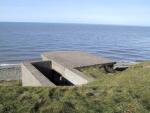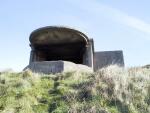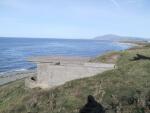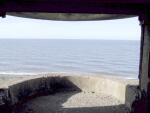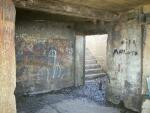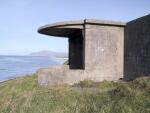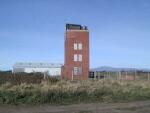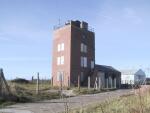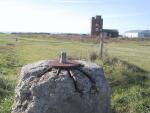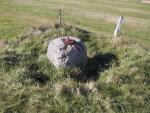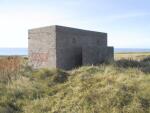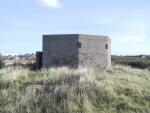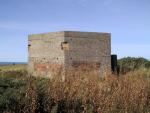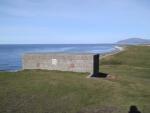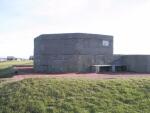WALNEY ISLAND COASTAL ARTILLERY.
Walney Island was home to two of Britain's many coastal artillery installations: The Hilpsord Fort on the south of the island - where the nature reserve is today, and Fort Walney to the north; described in the newspaper article below left, and now lost beneath Barrow's golf-links. Fortunately, an aerial photograph of 1940 exists, as do plans of the battery encampment. The architecture - at least of the remaining WWII searchlight positions - was similar to the batteries at Whitehaven and Workington. The WWII battery at Fort Walney was preceeded by coastal defences constructed in July 1911 and manned by the Lancashire and Cheshire Royal Garrison Artillery. The construction and initial testing of the 1911 battery is recorded in the article (left), and reprinted in its entirity with kind permission of the North West Evening Mail. It originally appeared in the July 29th 1911 edition of the "Barrow Guardian".
FORT WALNEY
Many thanks to David Parkin who provided photographs of Hilpsford Fort and notes, and Peter Cobb, who provided vital information appertaining to the Walney Island Defences.
The Earnse Point searchlight emplacements near North Scale (one is shown) were constructed as part of the original battery, but were modified for use during WWII. Construction was of a finer quality than the more austere WWII installations, and their vintage is given away by the sloping crown of the roof above the opening. This had the effect of ricocheting any shells away which might happen to land there. Inside, part of the steel door and sliding shuttering remains, and it can be seen where the rheostat and switchgear were attached to the wall. Small holes in the crown and side-wall were to allow heat to escape from the powerful arc-lamp and the stove, provided to afford a degree of comfort for the crew.
DEFENCES OF BARROW
Completion of Walney Fort
OFFICIAL INSPECTION; COMMENCEMENT OF FIRING.
The testing of the guns and mountings at the recently-completed fort on Walney Island on Wednesday morning,
and the inspection of the fort itself by General McKinnon and Brigadier-General Mcgregor, in charge of the
administration of the Western Command, signalised the success which has attended the efforts of the Mayor,
(Councillor T. F. Butler, J.P., D.L.) in connection with the defence of the island and Barrow. It was he
who first interested himself in the movement for the Walney coast defence, and subsequently, aided by Mr.
Charles Duncan, MP for the borough, was successful in prevailing upon the Government to vote a certain
amount for the construction of a fort, which was done on the condition that a detachment of the Lancashire
and Cheshire Royal Garrison Artillery be formed in the town. The contract was let in the latter part of
April, and the work of laying the foundation was commenced in March. The building work did not take so
long as anticipated, and on May 4th of the present year and erecting party of Regulars arrived, and
commenced to place the guns in position behind a breastwork of concrete. The fort itself is close upon 300
feet above sea-level, and the sand-dunes which arise up round about make it scarcely discernable from a
distance. The required force for a local detachment of garrison artillery men was raised very easily, and
the training which they have received under Captain G. H. Oughterson has brought them to a high state of
efficiency. Particular attention has been given to gun-laying with moving and stationary targets, the loading
teacher, range finding, and to the levelling and testing instruments, and practice at the battery itself only
remains to be commenced to bring the men up to the highest state of competency possible. |
The detachment is
not, however, without actual firing experience, for whilst undergoing the annual training at Altcar last summer
visits were paid to the Seaforth battery, where gunnery drills and firing practice were undergone. It is
probable that during the coming week the first visit will be paid by the men to the fort, and immediately upon
their return from camp, target practice will be commenced. At present there are but two 6in. guns mounted,
and it was the first firing of these which took place on Wednesday. The pieces had previously undergone tests,
and the main idea of Wednesday's firing was to ascertain the stability or otherwise of the mountings, etc, more
than the efficiency of the guns themselves. Half-a-dozen rounds of practice charge were fired, a couple of shots
point-blank, two at extreme depression and two at a high elevation, or a range of close upon ten thousand yards.
Residents upon the island had been forewarned of the firing, and given advice as to the best course to persue to
prevent sustaining loss through the concussion damaging window glass. The firing went off in a perfectly
satisfactory manner, and the inspecting officers were entirely gratified with the result. General McKinnon, in
company with Brigadier-general McGregor, Colonel Thompson, Chief of the General Staff of the Western Command,
Colonel Neville, General Engineer of the Western Command, Colonel Pratt, commanding the North-West Coast defences,
Major Jarvin, General Staff Officer, North-West Coast defences, Captain G. H. Oughterodd of the Barrow detachment
of the Lancashire and Cheshire Royal Garrison Artillery, and Lieutenant Robertson, of the Northern Coast defences
afterwards made a thorough inspection of the fortifications.
|
|
The BOP (Battery Observation Post) is currently used as a coast-guard look-out. The original observation gallery has been bricked up, and is discernible in both photographs. It is likely that the building is concrete, with the brick finish actually forming the shuttering. The roof of the BOP (where the little CG look-out box is) may have been used by the Royal Observer Corps during WWII, as it is on the same site as the UKWMO post. The post on the top of the BOP looks like a siren-mounting post.
The 29mm 'Blacker Bombard' spigot-mortar post is located such that it might have been used as an anti-shipping device as well as anti-tank. If this is so, it is the most northern anti-shipping spigot-mortar post unearthed to date (a title previously given to the Hilpsford Fort spigot-mortar described later). A War-Department boundary stone can bee seen in the spigot-mortar photograph which includes the BOP.
There are several 'Vickers-Armstrong' fire-watchers' posts dotted around the golf-links, two of which feature on this page. It is unclear whether they are located in their original positions.
PILL-BOXES AT WALNEY FORT - THE SOUTHERN-MOST PILL-BOX
There are two pill-boxes extant at Walney Fort, and they feature a very unusual loop-hole arrangement. The pill-boxes look like the normal type F/W 24, but the loop-holes are in the angle between faces, rather than the faces themselves. There are also larger holes beneath, in the faces. The pill-box immediately below still has the blast wall intact, and is punctuated with irregular holes where twigs were placed during construction to aid camouflage. A metal bracket on top of the entrance blast-wall was used for attachment to a camouflage net. Both pill-boxes have been bricked up.
Once used as a toilet, if the sign painted on the side is anything to go by! Identical (type F/W 24) to the southern-most pill-box, but has been built up at the back. Again, 'corner' loop-holes and larger holes lower down the faces.
HILPSFORD FORT, SOUTH WALNEY.
Hilpsford Fort was constructed during 1914 as a WWI emergency battery, and was dismantled in the 1920's, providing a source of much-needed labour to this employment-starved area. The artillery was reinstated in 1940, with new construction work undertaken. A 14-day job by the Royal Engineers actually took 19 days, due to 'bad ground'. Six-inch hand-loaded guns were employed, upon which the gunners of the Workington 406th Coast-Battery Home-Guard volunteers (amongst others) undertook several training courses, including firing common-point shells weighing 100lbs!
GUN HOLDFAST |
CASL EMPLACEMENT |
GUN HOLDFAST |
SPIGOT MORTAR |
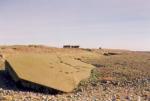 |
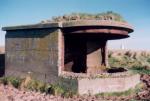 |
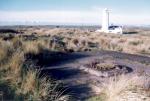 |
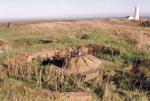 |
Home | Contents |
Workington | Links |
E-Mail

